Page updated: 31 December 2009
The event described below is not a conventional race for sailing craft. If you are not familiar with the course and the kind of craft that take part, then you should read a little about the Three Rivers Race before continuing.
 Paperwork and Problems
Paperwork and Problems
The idea of taking part in the "Three Rivers Race" had captivated me since the time I first heard of it. Even with the decision to attempt it made, with no history of racing, I was reluctant to think of myself as a true competitor. My ambition was to only to complete the course.
In November 2005, following the guidance of others on the NSBroadsboating YahooGroup, whose subscribers include a number of experienced 3RR competitors, I sent an SAE to Colin Facey at Wood Dyke Boatyard. I was warned not to expect any response until late February. In March the papers turned up.
Those papers produced the first hurdle. As a first timer on the Three Rivers I needed a "Flag Officer" to act as a referee. I had no idea what constituted a Flag Officer, let alone knew one. It was back to the mail list. Typical of the helpful sorts there, one of the regular contributors said they would be happy to introduce me to a suitably qualified friend, who was involved in the Horning club itself. So, one Sunday, I turned up at Horning to meet both Richard Baguley and Mollie Howes, his flag officer contact.
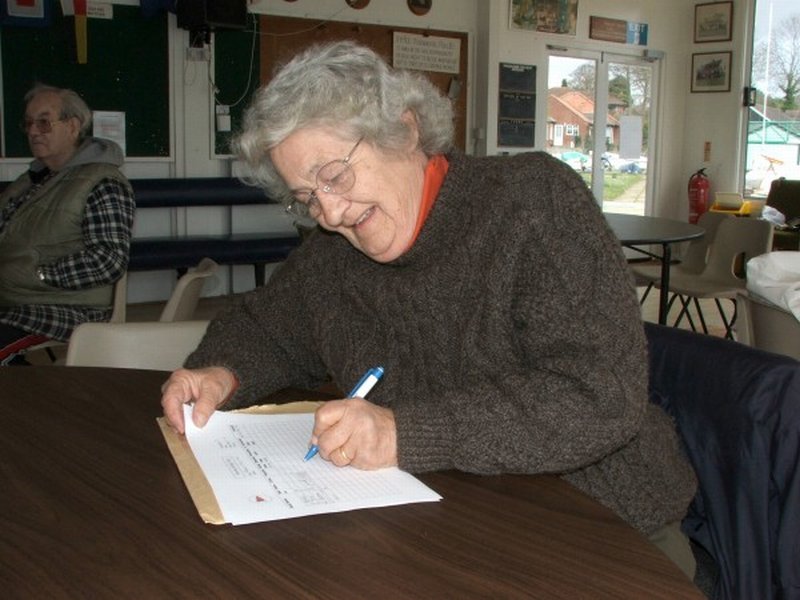
Mollie Howes, interrupted from her time-keeping, to sign my application form.
I went armed with a copy of an e-mail that I had sent him that explained my full experience. The "interview" wasn't arduous. It was a casual conversation interrupted by passing Rebels and Reedlings, whose positions needed to be marked on a chart as they raced by, just outside the clubhouse. I left with the necessary signature on the form, and together with the cheque for the entry fee, dropped the form off at Woods Dyke. It was a fortnight before the 24 April deadline for entries. "What have I done?" I wrote in my thank you note. "You will find out, Greg. You will find out!" came the response.
 Planning
Planning
The next stage in planning for the race was to get in a bit of practice. My brother Mike, and his wife Mary, came to stay for the week end at the end of April and we went for a sail. From the sailing perspective the purpose of the visit was for Mike, who was to be the second member of the crew, and I to test a variety of ways of dropping the sails and mast. It didn't work out that way.
Before we set out we were able to test a couple of things. After two years of ownership, I finally tried hoisting the spare jib. This was a sail that came with the boat when I bought it on Easter day 2004. I'd laid it out on the ground a couple of times and it appeared to be the size of a SeaHawk genoa. However, it had a Flyde sail makers mark on it, not Jeckells, so clearly was not an original.

Mike begins rigging Imagination for the cruise to practice mast dropping. The mooring is in the Pleasure Boat Inn dyke, beside the pub's garden!
The sail I knew to be in excellent condition. The brass clips, to fasten it to the forestay, still gleamed and the cloth retained all the stiffness that you expect in a sail with little wear. I doubt that it could have been used more than a couple of times. Anyway, up it went and it was clearly a foot or so too long in the luff, so back it went in its bag and a mental note made to check with Jeckells, before my next attempt on the race, to see how much it would cost to remodel it.
The leech of the standard SeaHawk jib falls level with the mast, in contrast to most modern boats where the boom is made shorter on each new design. Although the modern sail plan may be more efficient on open water, where a tack is a relatively rare event, on the Broads you can spend long periods where one is never more than a minute away and frequently less. In these circumstances, a sail that comes across and re-sets quickly is considerably more efficient than one where the crew exhaust themselves working the jib sheets and the sail is not properly set until it is time to come about again.
Having got out on Hickling Broad, it was unfortunate that we didn't do much more than stooge around and give Mike a chance to get a feel for the boat, especially in the narrower channel through Deep-Go Dyke, at the far end from my mooring. At one point I suggested we use the channel posts to represent a bridge and see how quick we could get the sails and mast down but, in truth, we never did attempt it.
All we managed was to drop sails and mast just once, in the middle of the Broad. It taught us a number of things: how we were going to manage the boom, how we would secure the shrouds and other loose lines and what we were going to do with the tiller if we were both going to be paddling under the bridges.
The traditional Norfolk Wherry, has a single loose-footed gaff rigged main sail. It is simplicity itself to sail right up to a bridge, loosen the peak halyard and drop the mast, and do it within a few feet of the bridge. It is said that some crews would allow the forestay to touch the bridge as the sign of when to lower the mast! Such techniques are not possible on a SeaHawk.
A tabernacle is a major help, allowing the mast to pivot level with the top of the cabin door so that the mast can lie horizontal. Having the mast horizontal is virtually essential if you are to pass under the old bridge at Potter Heigham. The boom is the next big problem. The track for the goose neck does not run far enough up the mast to allow it to clear the cabin, even if there was sufficient flexibility in the goose neck to allow the boom to remain attached to the mast and lie in the cockpit.

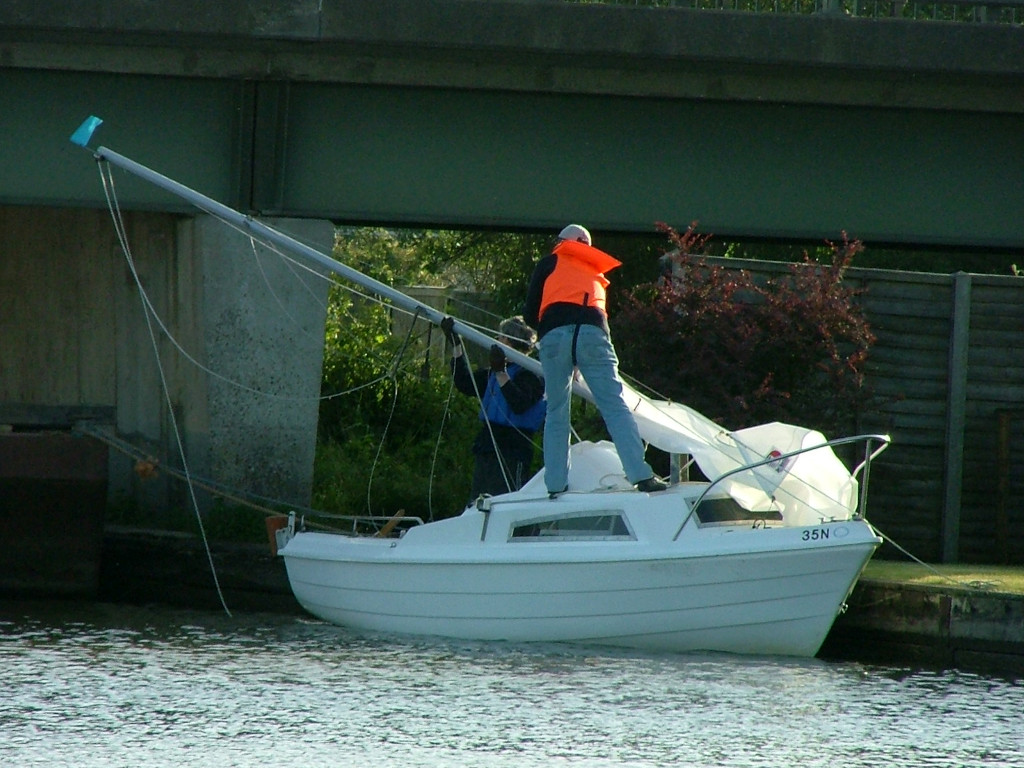
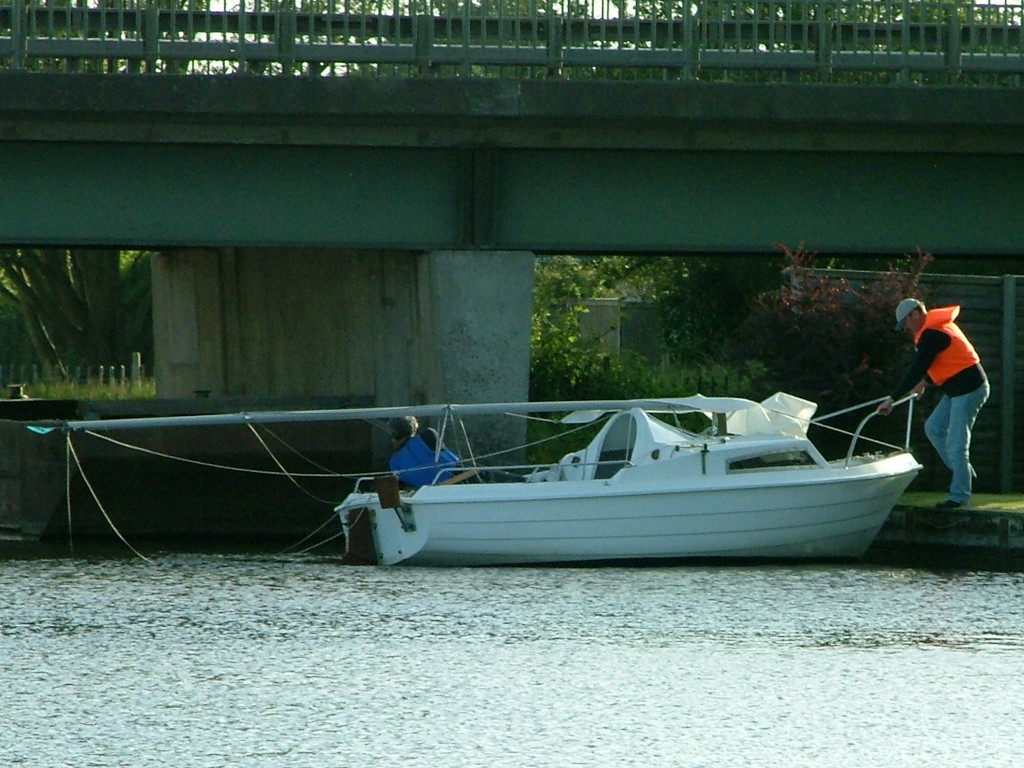
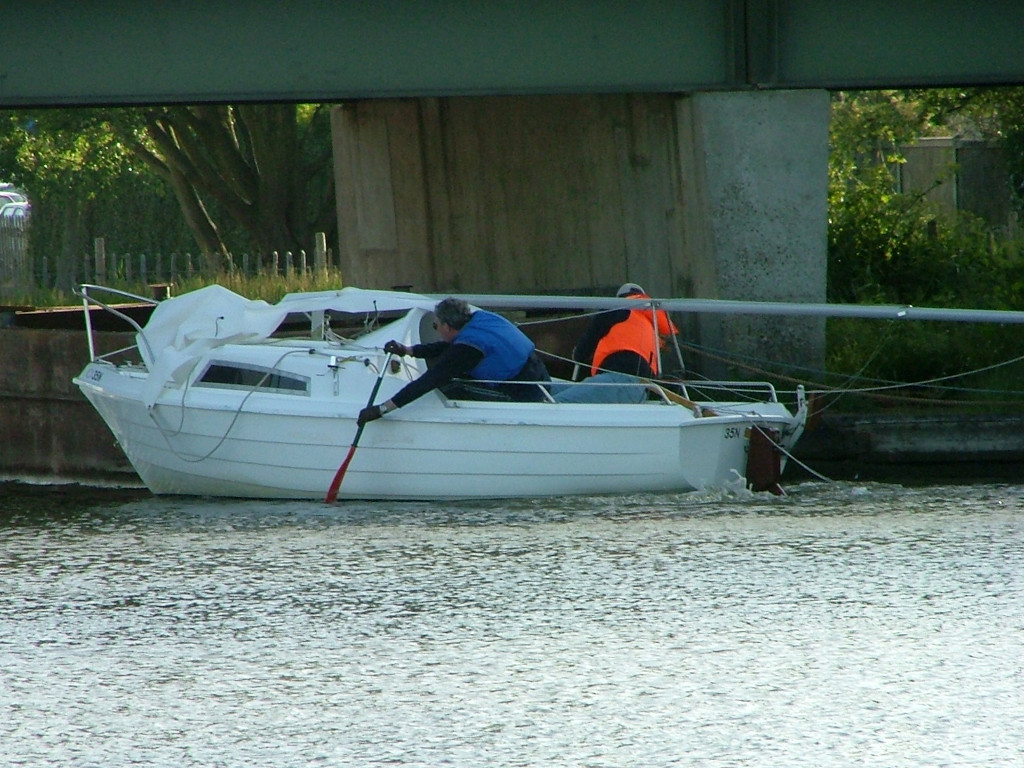
© 2006 Jerry Ping
Here, during the 2006 race, we prepare to pass under the bridges at Potter Heigham for the second time, and the sequence used for dropping the mast can be seen.
It became clear that without some further work on the rigging and some practice time, and that we hadn't got, our approach would have to be: slacken the fore-halyard; unshackle jib at the tack; drop the main, rolling it round the boom; lift goose neck out of mast track and stow boom in the cabin; lower the mast; turn the boat in right direction; paddle like blazes! I considered trying to attach the jib to the point where the steel forestay joins the rope halyard. However, that only shifted the need to add slack at the cabin top cleat instead. I didn't consider worth the experiment during the race itself, and I've yet to try it under non-racing conditions. I might, if I ever reach the point of re-arranging things so that I can do all mast lowering from the cockpit.
It wasn't all work preparing for the race. I don't usually have crew aboard, so I took the opportunity to get some pictures of "Imagination" under sail, when I hopped ashore with my camera in hand. I had wanted to get some pictures of the boat with her new sails, only picked up from Jeckells a couple of months before and being tried for the first time.
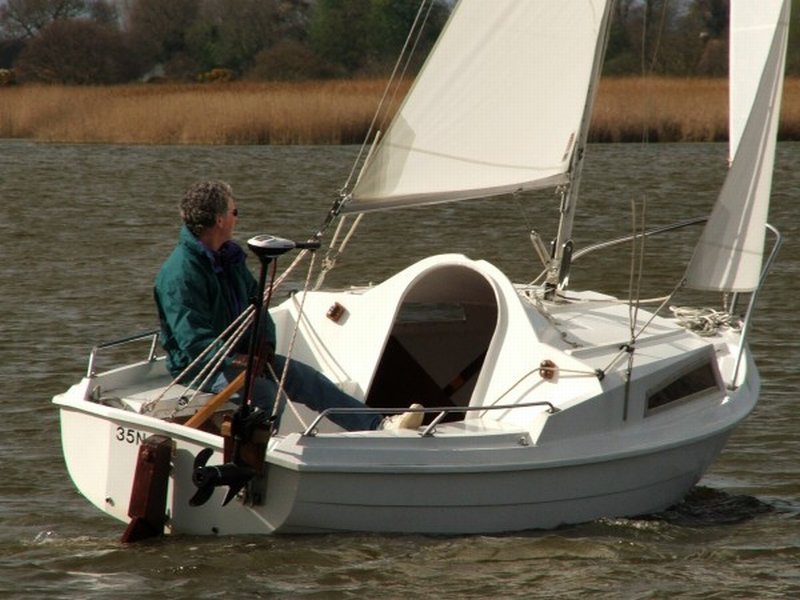
I hop ashore at the White Slea moorings to get pictures of Imagination under sail.
On 10 May the papers arrived confirming my application had been accepted. This raised a fresh set of problems. There was a long list of items that the rules required I had to have on board when starting the race, some understandable - life jackets, food and drink, navigation lights, a torch - and others obviously part of the arcane arts of racing, a rectangular burgee and red and green flags, for example.
Once again I was back to the mail list seeking guidance from the more experienced. In the end I decided against some of the advice offered. The items were not too expensive and so I invested my hard earned cash in the appropriately shaped and coloured flags at Norfolk Marine, the biggest chandlers in Wroxham.
Next there were the mechanics of taking part to consider. My mooring was on Hickling Broad. I figured it a six hour cruise to Horning. I wouldn't be able to do that immediately before the race and I didn't trust my electric outboard to take me all the way any faster. More help was offered from the mail list. However, I ended up turning down the use of a petrol outboard as I'd managed to find a berth in Horning which would allow me to stay there a fortnight before and after the race - for the price of a pint! Truly, uttering "Three Rivers" really does seem to be a magic phrase and brings out the best in people.
At this point, because my brother lives in Surrey, Liz, my wife, decided she needed to start organising things. Searching the net for a riverside cottage at which we could all stay, she came across "Horning Holiday Homes". Unbelievably, the company still had available a couple of properties that offered the ideal Friday start. Once more the magic phrase "Three Rivers" was uttered and we found ourselves not just with the use of a waterside chalet for the weekend where our English Setter could also stay, but an offer to scrutineer the boat as well. Yes, the owners of the property letting business were keen boaters and normally took part in the race themselves.
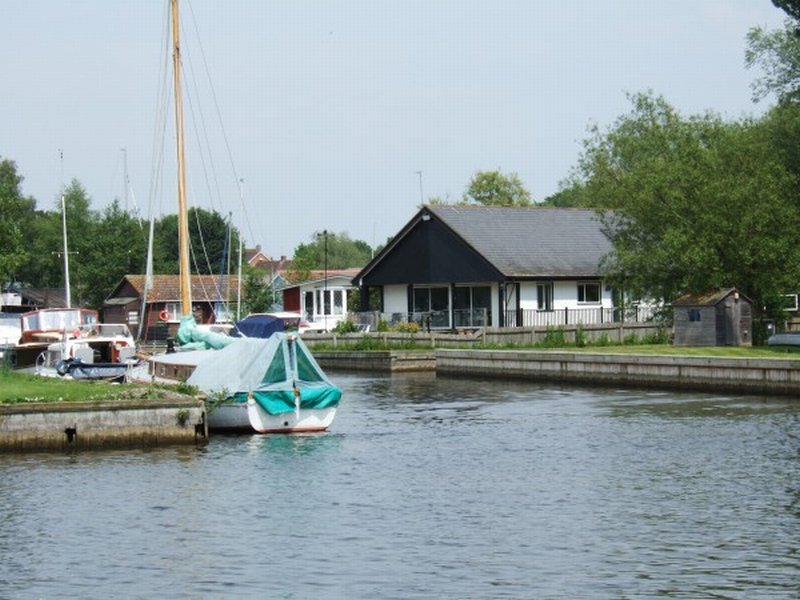
© 2006 David Gibson
Quiet Waters was the impressive chalet that we rented for the week end.
Seen here from across the river, it fronted one of the many dykes.
 A Cruise to Horning
A Cruise to Horning
On the Sunday a fortnight before the race, I set out to bring "Imagination" round from Hickling to Horning. The forecast had said wet and windy and generally miserable, on not only the Sunday, but right through the first half of the week. So I thought, it had better be Sunday then, as I couldn't do it at the end of the week and the following week end was reserved for other domestic business.
After visiting the chandlers on my way, I arrived at the boat to discover someone had been tampering with it. Mooring lines had been adjusted, fenders re-sited, and when I went to hoist the sails it seemed that somehow the main halyard had become caught on something inside the mast. Eventually, I was able to free it and I never did find out if the visiting card, from a new Horning-based chandlers, left on board had any connection with these unusual goings on.
I finally got away from the Pleasure Boat at around 12:45. With the wind in the South East, it was one of those rare days when I didn't even use my outboard to get out of the dyke. Then tacking across the broad, and all the way to Martham, it wasn't until I turned out of Candle Dyke that I managed any worthwhile speed. I had been forced to put on my Barbour Jacket by this time, I'm not one with posh clothing especially for sailing, as the first of a whole series of light drizzly showers started, after a wonderfully bright morning.
 Potter Heigham
Potter Heigham
I moored to drop my mast at about 14:20, used the motor to pass through the two bridges, coming through in slack water, and hoisted sails again. That all went quite smoothly, taking little more than fifteen minutes.
It's years since I've been below Potter Bridge. I had forgotten how much tighter the bungalows are packed in south of the bridge and the first mile down "the street" took the best part of an hour. So much for the forecast near gale conditions! The map indicates I should have had the wind on my beam most of the way but, at times, I was having to tack. Caused, I guess, by an undertow effect as the wind came over the buildings and curled back in the trough between the two lines of shacks.
I'd stopped calling them bungalows by this time! Not least because my one encounter with a moored boat was with the bowsprit of a well cared for half decker, tucked end on in its dock. And it just had to be outside the first occupied shed I'd seen in forty minutes! I'd passed scores of near derelict-looking chicken coops, and then messed up bringing my SeaHawk about and was swept broadside onto the moored boat, entangling main sheet and cockpit guard rail with said bowsprit. A quick leap ashore and push of the bows and I was gone again, but it was an embarrassment.
 Past Thurne Mill
Past Thurne Mill
Eventually, I emerged from the buildings to see Thurne Mill south west of me across the fields. However, the river follows a long two mile semi-circular curve before it gets there. I was making good progress again. The cloud lifted a little, and my jacket and over trousers were beginning to dry out in the good breeze. My only disappointment was that "Hustler 4", one of the wonderful Hunter's yachts, with three men aboard, appeared behind me. It wasn't behind for long. "I knew I'd never be able to keep ahead of the Hustler" I said to the crew as she came past.
But soon, as the curve continued we reached the point where we had to tack, and my spirits soared. She had got a hundred yards ahead but wasn't making any further progress. Indeed, at times, I was gaining on her. I was holding my own because I was pointing fifteen degrees or more higher into the wind. She was fast alright, bouncing back and forth between the banks with all the speed of a ricocheting pong ball from a 1970's video game. She was being helmed like a dinghy, with ninety degree tacks made at lightning speed, whereas I found that I had enough momentum to run straight up into the wind on each tack before bringing her round, leaving a long gently curving wake, extended by the tide which was now flowing against us both.
This battle continued until Thurne Mouth came in site. At the same time, the Wherry "Albion" swept round the corner, a group of four or five people on her bows and two in the stern. Albion, running, hugged the western bank. As I tacked on the opposite side I had time to call to a guy attending to "Breeze", a well maintained River Cruiser at, I supposed, the end of his day's sailing. "Isn't your boat the one with the web site that needs updating?" I yelled. It took the surprised owner a few moments to respond. There was a brief exchange with the guy on the neighbouring boat, also being battened down at the end of the day. There was just time for the explanation that both their boats had been the subject of son's "A Level" assignments. So that accounts for it, I thought. The reason there are so many quite nice sites out there that seem to get forgotten after initial production. They are just one-off examination pieces. It seems a shame more are not maintained, but understandable if that was the motivation for the initial construction.
And then quite without warning the battle was over. Just short of Thurne Mouth Hustler 4 suddenly turned and headed back towards Womack Water. There was time for a cheery wave from all the crew as we passed. I prided myself that the smiles were an acknowledgement of the fine job I'd done on keeping up with them. More likely it was a response to the stupid grin I had on my face.
 Up the Bure
Up the Bure
I turned into the Bure at 15:55 and with a fresh wind on my beam and the tide in my favour, for the first time I was really flying. St Benet's Abbey was soon in view, then passed. Ahead was yacht coming downstream. It aimed for the bank opposite Ant Mouth and dropped its sails. As I passed I realised it was "Ripple". A photograph of her had appeared in the then current edition of Norfolk Afloat. I remembered her as the sister ship to Buzzard the yacht that I'd hired with my younger brother and two school friends back in 1966. I just had time to confirm with those on board that this Ripple was indeed once part of Loynes fleet in Wroxham, but the owners did not know what had become of Buzzard.
Now the trees were closing in fast. I began to recall my personal rule of thumb when choosing where to fly a kite. "Trees affect the wind for twice their height above them and ten times their height downwind". Now I debated whether I need to change that rule to twenty times their height downwind. Although nominally the wind was behind me or on my beam, at times I began to wonder whether it hadn't veered and I ought to be tacking, but I kept gliding onwards, half carried by the tide as much as the wind, which was still tickling the tops of the trees with the smallest tips rushing from one side to another like some child trying to escape the catcher in some playground game of tag. Back home and looking at the map, I realise why I became confused about the wind. I had forgotten quite how many turns there are in the river as one passed to the north of Ranworth and Cockshot Broads.
 Approaching Horning
Approaching Horning
The river was becoming busier all the time. By now all the other sailing boats I saw were running on the "iron sail". With intermittent drizzle again, it was surprising to see quite a number of hardy holiday makers in day boats. These, of course, are not the open-backed day boats with a collection of "Lloyd Loom" wicker chairs that I remember from my teenage years, but the fully enclosed "picnic boats", with galley and toilet on board. Some occupants of these even managed a cheery wave, probably thinking how much better off they were in the dry. One large sea-going cruiser with a marine blue hull came past at a rate of knots and a wash to match. He gave a cheery wave too. But I never spotted the name. I was too busy muttering curses under my breath following a soaking from a flick of the mainsail as I was tossed about in his wash.
If it had been twenty years since I had seen south of Potter Bridge, then it must be fifteen years longer since I have seen Horning from the water. Of course, I had seen the maps with many more dykes than I remembered from the 1960s, and I have driven past the new two storey holiday lodges and boat yards at the eastern end of the village, before it climbs to higher ground. But I hadn't seen it from the water. Whereas my memories of Potter weren't out of keeping with what I found today, a mix of modern or well maintained bungalows and scruffy run-down shacks, Horning was different. Horning had money. Horning had new buildings, new quay heading, new "Private Moorings" signs, new everything! Horning had bustle. Even today as I entered the final reach before "The Swan", there was activity. While there weren't anglers sitting by their rods on every lawn, you could see them behind their patio-doored waterfront palaces, consoling themselves with their Gin and Tonics - and this before 18:00 too!
At this stage it was truly raining. There was no dark patch above with lighter skies and an obvious end to a shower. However, the wind was dead astern and more constant, allowing me to gull-wing down the to turn by the Swan. I did think about exploring round the bend to see what changes were to be found there, but the mobile phone of the guy who was due to meet me was in divert mode and I couldn't reach him to check on the final arrangements for where I was to moor, so I decided against it. I'd love to tell how I made contact with him and how I was offered a free mooring. The magic words "Three Rivers Race" seem, once again, to have been the key. Suffice it to say I was asked not to spread the story, in case it should start a flood of request in future years. As I tied up it was around 17:45, so the trip had taken five hours. All I needed to do is work out the implications for the order I ought to do the marks on race day.
 The Race Weekend
The Race Weekend
A few days before the race we called the people at the holiday lettings company to confirm our planned arrival time. They offered profuse apologies for not being able to meet us at the chalet. They had to be at a ceremony scattering the ashes of a sailing club member at South Walsham Broad when we expected to arrive. However, we would be able to pick up the keys from the chalet next door.
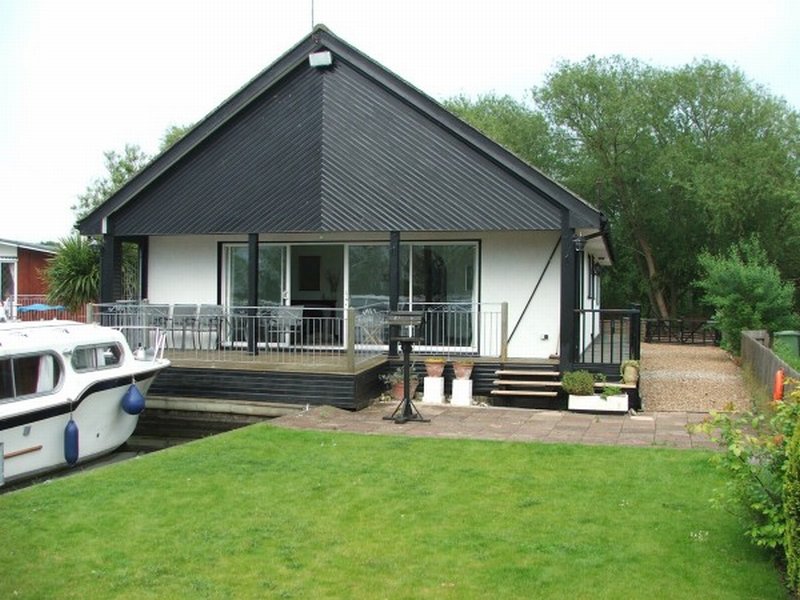
Quiet Waters' fully fenced garden meant that Zena, our English Setter, could roam free. Only the boat dock had no fencing, but that was not a worry.
The race weekend arrived and we picked up the keys from the neighbouring chalet. You've guessed it. More boaters. This time the people who will be on the guard boat at South Walsham. They even made an offer to scrutineer our boat but we decided it would be too much hassle to bring it up from its mooring to the chalet and get it back in the morning. My brother, Mike, and his wife, Mary, arrived about four hours later, after a long struggle through the London exodus traffic. We are all in high spirits as we settled down for the night although, in retrospect, the way the wind died almost before my brother had arrived boded ill for conditions on race night.
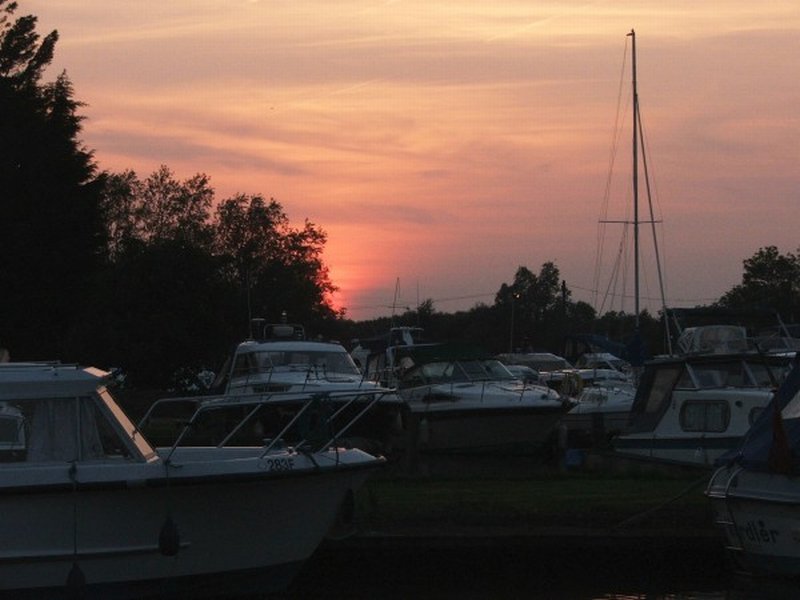
The wind dropped before eight o' clock and at ten to nine the sun was setting, providing a fine view across the boat filled dykes in front of Quiet Waters.
 The Morning of the Race
The Morning of the Race
Come morning, we had a hearty breakfast and Mike and I then went down to the slipway opposite to where Imagination's had spent the last fortnight. We took one of the dinghies waiting there, rowed across, and returned to pack as much of our gear aboard as possible, before going down to the Sailing club to register and get the boat scrutineered.
At this point I realise that I had managed to misplace the new shackles I had bought. These had a twist in them and I believed would make life easier when lowering the rigging. The ladies, who had joined us by now, were sent hither and thither to look for them and having found them back at the chalet, returned. Unfortunately, in my stressed state, I didn't quite offer the thanks that I should have done. Liz has not let me forget this and on it lays part of the reason for not taking part in the 2007 race.
Tension aboard settled down and we waited for scrutineering. Although we were told that the club had decided that "scrutineering" was a little too formal a term, and "checking" was now preferred. I did the couple of jobs necessary to prepare the boat. Not normally being a night-time sailor and never having been beyond the Broads, I needed to fit navigation lights.
For this one-off use I had bought a set of "emergency lights" designed to run for just eight hours on a single "D-size" battery. I used lengths of "ratchet strapping", normally supplied to hold electric cables in place, to secure the plastic clips that would hold the lamps in place, fixing them to the plates at the base of the shrouds. To get them tight enough, I padded the brackets with small pieces of pipe insulation. I carry some of that to cushion the mast when trailing the boat.
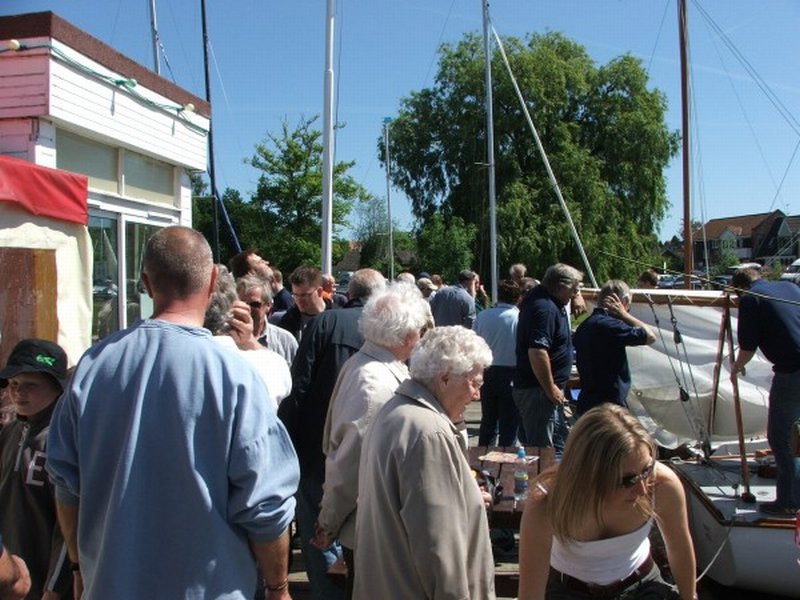
Crowds mill about Horning Sailing Club, crew and supporters, preparing their boats for "checking" and waiting for the race briefing.
The checking went painlessly enough. The one thing that I thought almost over rigorously checked were the lights. I had to demonstrate a working set of batteries in each one. Other rules, such as "No Alcohol", did not seem to be a major concern. In fact, we had none on board. There wasn't room. Mary and Liz had together ensured that there was almost no room for the crew. The casual observer might have thought that we were provisioned for a trans-Atlantic journey, rather than an overnight hop down the river.
Another of the job I did at this time was to tie a small torch, with a single LED bulb, to the burgee halyard. Advice given by previous competitors had suggested a good sight of the burgee at night could be vital if you were to make progress in the almost guaranteed light airs overnight. Rules were strict, banning masthead lights and I chose this torch because it was well cowled and would only shine straight up at the masthead.
It was also in this period that Tim Stringer appeared out of the crowd an introduced himself. Tim, I had never met but felt I knew him well. It was he who had pushed me towards buying a SeaHawk, a boat I had been trying to avoid. Indeed, it was Tim that pointed out the eBay ad for the boat I eventually bought, so my participation could be said to be all down to him. Tim was also able to provide much guidance on completing in the Three River Race, as were a number of other subscribers to the now defunct NSBroadboating YahooGroup.
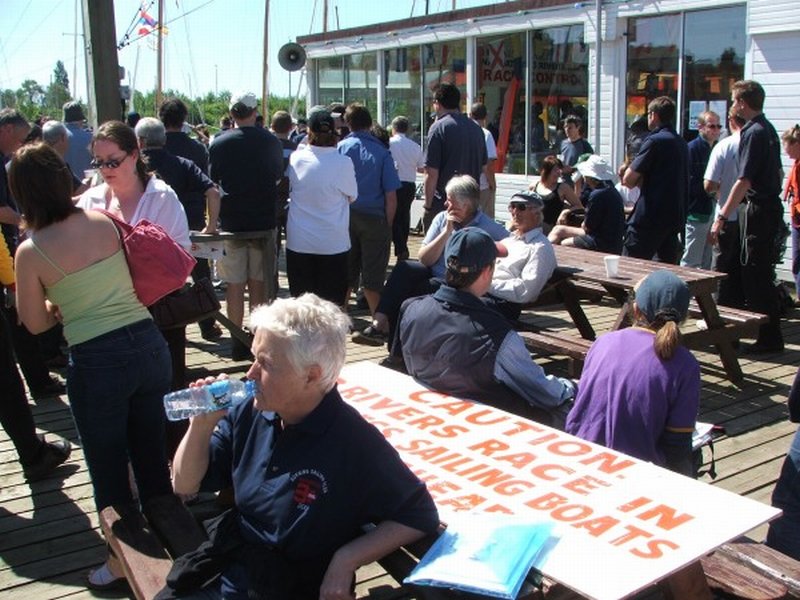
A competitor, wearing the new 3RR polo shirt, takes a drink by a warning sign, unused this year, that lays on one of the tables outside the club house.
Then we were called to the skippers briefing. The key bit was where the lower Bure mark was to be laid. This year it was to be the middle of the three possible points, at the Stracey Arms. I must admit to expecting a more detailed weather forecast than the one offered, which was no more detailed than that which I saw on BBC's "Look East" the previous evening. But, with hindsight, I can see that there was probably little point in attempting anything more exact. After that it was hoist sails and clear the "X Zone", the area immediately behind the start line.
 The Start
The Start
With almost one hundred boats taking part, a single start is impossible in the narrow confines of the Bure at Horning. So, as with the London Marathon, the start is staggered. The field is separated into a range of classes and each one has its own start at fifteen minute intervals.To avoid having too many boats waiting for their turn near the start, the organisers declare a hundred yard length behind the start line declared as the "X Zone" and it is banned to all except those awaiting the next start.
For each class the start is, as with a conventional sailing race, triggered with a series of warning guns before the start and then the skill is in timing your approach to the line as the final starting gun goes off. Go over the line early and you have to make a 360° turn and re-cross the line as a penalty.Timing a start always requires skill and at Horning doubly so. This is because the start line runs diagonally across the river from the club house to a post on the far bank of the river. Somehow, reckoning whether your bows have crossed the line seems trickier when you are sat aft in the cockpit and the start line is a diagonal. The diagonal start line is an understandable device, as the river takes a 90° turn immediately after the start, and and without it boats forced to the outside of the bend as they approach the start would be doubly penalised. However, this makes the helmsman's decision on how to approach the start still more complicated than usual, as the turn needs to be considered as well as where to aim for on the start line and the relative position of the neighbouring boats.
The first start is a group mainly comprised of Enterprises and Wayfarers. Next go the Norfolk Punts, one of two classes that consistently share the prize for fastest boat home. A number of groups follow, for each of the popular local day boat classes. Then the Thames A Raters. These are the second of the "extreme" boats, with masts as tall as the clouds, on hulls seemingly little bigger than a surf board.Three groups follow, the River Cruiser Class boats. These are magnificent examples of traditional Broads yachts, and are probably the spectacle that most visitors turn out to see. A group of these boats, making their way down the relatively narrow heavily tree-lined river, with their huge gaff rigs, complete with top sails are an imposing, even terrifying, sight - especially to a novice crew fresh aboard their hire cruiser for a week's holiday.
Then follow the Hire Cruisers. Yes, it is possible to hire a yacht for the week of the Three Rivers Race and take part in the race itself. It takes a bit of planning and permission of the boat's owners, but probably, most of the hire yachts out that week do take part.
Finally, there are the "sailing cruisers". Our boat was in this last group. Once the briefing was over Mike and I decided it was time to leave the club dyke and head up river to await our start. We would have an hour to wait upstream until it was our turn, but we figured it should give us a chance to relax away from the crowds and prepare ourselves for the start.
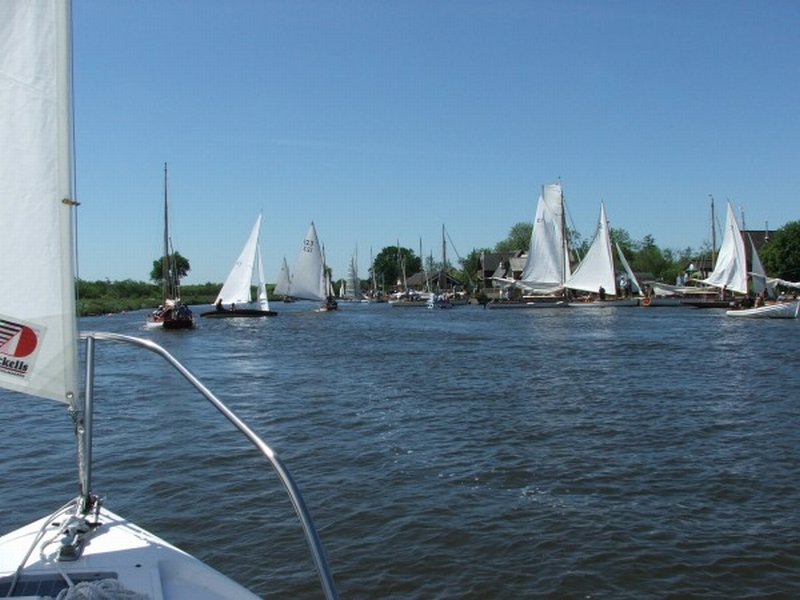
Going upstream to wait for ourturn, we cross the start line and pass through the "X Zone" to join boats moored or loitering awaiting the start of their group.
The river was crowded with many of the larger craft occupying all the early moorings and busy hoisting sails. Mike and I moored at the first vacant spot, outside an unoccupied chalet, and ate a sandwich or two. The weather was perfect, brilliant sunshine and a good breeze. The approach to the start line would have the wind on our beam and astern after the turn. That would mean that there would be no hassles with fighting for water as boats tack in front of you. There couldn't be an easier start for a novice.
We didn't see much of our opposition while we took our lunch. The smaller "sailing cruisers" of our class either had not set out from the club as we had or were hidden further down the bank by the larger craft still making ready. We could, however, chuckle at the misfortunes of the crew of a hire cruiser struggling to get their topsail set.
Then our turn arrived. We cast off and made our way down to X Zone to hear the first warning gun for our group. "Ondine", the one boat I had looked forward to seeing, had scratched from the race. This was one of the boats, a Timpenny 670, that Tim Stringer had owned after his SeaHawk. He had sold the Timpenny to David King. Both were active members of the NSBroadsboating mail list and, in 2005, David had invited Tim aboard for the race. The year that Tim had finally been able to claim as a "finish", an achievement never accomplished, in spite of several attempts, in his SeaHawk. Also withdrawn, we discovered later from the results listing, was "Water Bunting", but we had no time to work that out as we approached the start line and circled, trying to establish a mark by which we could judge how far forward to come without risk of jumping the start.
Then we made the final turn and raced for the line. Clichés about time slowing down seemed to come true. Several other boats seemed to have the same sensation, and we all turned away from the wind and skipped along the start line, waiting for the gun. As we did so, it meant we were going backwards. We moving away from the 90° turn down river. All things considered, initially, I thought we had made a good start, but as we made the turn at the Swan, a couple of the larger rigged boats managed to pinch our wind, gain momentum, and we found ourselves fourth in our group as we started down Horning's "Street". At this point we were just a few yards directly astern of "Y Knot", the only boat in our group that was to complete the course within the twenty four hour limit.
Before the race "Ondine" had been my target boat. The one against whom I was going to judge myself. It would have been an unfair race. According to the handicapping system she was some 25% faster than us, but she was to be crewed by people I knew. Then as we had raced to the turn I could hear the commentator on the public address system listing a stream of prizes that "Brown Owl", the Sailfish, had won over a number of years. The Sailfish was the only named class within our group. All the others were classed as anonymous "sailing cruisers". The Sailfish, however, was also rated a 23 on the Three Rivers Handicap system, though according to the Portsmouth yardstick was significantly faster than a SeaHawk. It became our new target boat. I had to aim to finish ahead of "Brown Owl".
 Through Horning
Through Horning
With all this activity going on, we had completely forgotten that on the lawns by the Swan Hotel would be Liz and Mary, with Zena, our English Setter, too. We didn't know that by now Angie, Liz's sister and John, her husband, and their son, Chris, would all waving madly at us, cheering us on. Woe on us for forgetting to seek out their faces in the crowd and wave back.After the hassle with the shackles, it turned out to be the second big mistake!
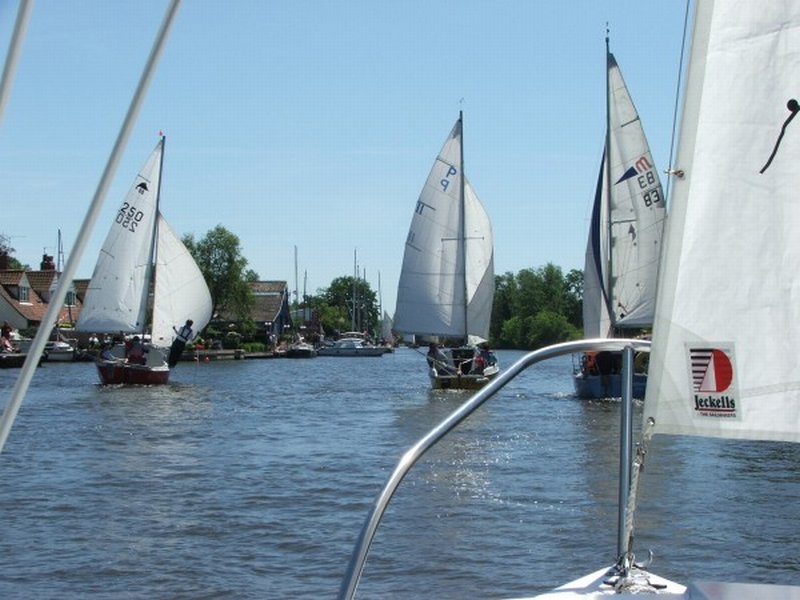
Imagination is a respectable fourth in her group on making the turn
immediately after the start and heads off through Horning.
Once running down Horning's "street", life was a little more relaxed. I even had time to take a photograph. Something that wouldn't have happened had the wind been against us. The street may sound a strange, but even Arthur Ransome described it that way in "Coot Club", one of the Swallows and Amazons books, as so many properties front onto it, rather than the roads behind them.
It was interesting the see how the various boats performed. Concentration seemed to be the key to making good progress, though that was difficult as there were so many distractions. Even though we were one of the least impressive boats in the race there were still many spectators on the bank cheering us on and expecting some response. The result was that we swapped position with some of the supposedly faster boats in our group a number of times before we left passed the Ferry Inn.
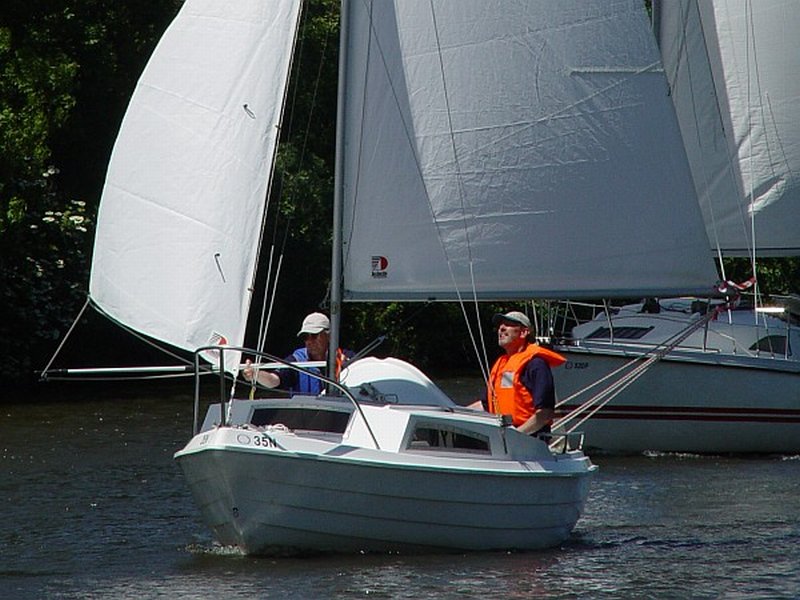
© 2006 Craig Slawson
Mike uses a boat hook to ensure the jib sets well,
whilst running through Horning's "Street", shortly after the start.
Then, as the trees closed in on the river and the last of the chalets were gone, I ran aground. You can put it down to over optimism. A SeaHawk's lifting keel swings down like a dinghy centre-plate. However, even when lowered its leading edge has a considerable backwards sweep. Knock into anything solid and it tends to lift and slide over it. However, this isn't true of broadland silt. It slices its way into it, slowing the boat imperceptibly until you suddenly realise you are no longer moving. The silly thing is that I had seen another larger boat ahead do the same thing. In my naivety I assumed that we would pass over the bar that we had found. Not to worry! Just grab the handle on the cockpit threshold and lift. This we did and easily passed over the silt, although it did mean that "Brown Owl" was now well ahead and only spotted momentarily as we followed round each bend.
Just before the Ranworth Dyke, fifty four minutes after our start, we spotted our first boat in trouble. It was Vagabond, one of the faster boats from the first of the River Cruiser starts. We couldn't work out what had happened. Perhaps she gybed and caught her mast in the trees. There seemed to be some damage and the crew appeared either to have already abandoned their race or were still undecided what to do. We passed her and she was still in the trees when we rounded the next bend.
The trees of Horning finally recede from the river banks and we emerged into a steady breeze. I was still undecided about whether to tackle Fleet Dyke and the South Walsham Broad mark when outward bound but I was clear that we should have time to do the Ant and pass the Ludham Bridge mark and still make the lower Bure mark at around one o' clock in the morning. The tide table I had seen predicted low water at 00:43 but I supposed slack water would be a little later. I wanted to do the Hickling mark before that, as I expected to be able to use some of the tide going up the Thurne. I figured the larger boats would want to avoid Potter at high tide so should not be there taking all the wind from me. Then we could use the ebb all the way down to Stracey. That was the plan.
 The Ant
The Ant
With the wind astern most of the way to Ant Mouth, we'd made reasonable time. I picked up my voice recorder and noted the time of the turn as 14:34. All the larger boats appeared to have cleared the Ant so when we got there the going was easy.
For the larger River Cruisers, the Ant can be a real pain, especially when the wind is in the wrong direction. It is narrow. For some, in some places, it is no more than two boat's length across the river. Even on this day, with the wind essentially on the beam, some reaches required tacking. I can imagine that earlier in the day there had been some real hassle for some of the crews. They would have been fighting other boats for water on the tack while steering a course around those returning down river from the mark just below Ludham Bridge.
For a seventeen foot boat the river itself creates little difficulty. The scrub is now reasonably far from the banks and the reeds, though tall, do not really impede progress. With no boats to overtake and few to negotiate coming the other way it was simple. We made the mark within ten minutes.
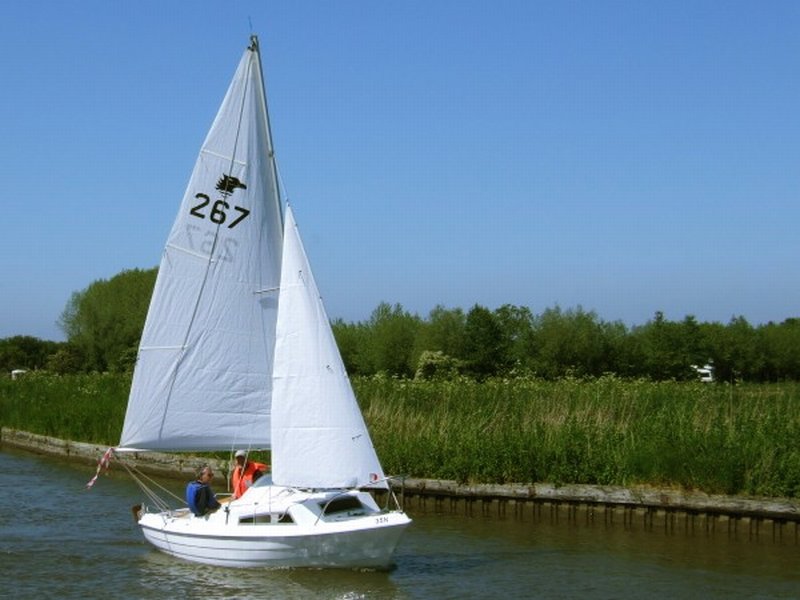
© 2006 David Gibson
Imagination, having turned at the mark, makes her way downstream to Ant Mouth again.
A few years before, Mike and I, with Liz and Mary, had stood at the mark watching boats make the turn. Other were doing the same today. Suddenly, I realised it was friends from Cambridgeshire, David and Eunice Gibson that were on the bank beside us. In a hurried conversation we established that they had their caravan nearby, and I invited them to call in on Quiet Waters. They had Liz's mobile phone number and could give warning of their arrival. Later, we found out they had found their way there, and some of the photographs on this page are theirs.
But it wasn't just friends who were there. Next someone was introducing himself as Jeremy Nunns. Jeremy and I had frequented the NSBroadboating and Camboaters YahooGroups for some years. I have great respect for Jeremy, who always wrote great sense and seemed to spend much time on the Broads coaching crews of young people. Later, there was to be much banter on the NSBroadsboating list, about whether, given the conditions on the day, it was appropriate to back the jib on every tack or not. Certainly, I didn't. I only needed to when I made a mistake. Generally, I was able to use Imagination's momentum to carry the boat parallel with the bank for at least a boat's length before bringing her onto the next tack. Given her short length, was able to make enough speed across the river on the new tack to employ the same trick again when it came to turn again, in just the way that I had been able to keep up with Hustler 4 a fortnight before.
We were back to Ant Mouth by 14:54 and had only five hundred yards to make the decision on whether to tackle Fleet Dyke and make the mark on South Walsham on this outward leg, or whether to wait until the return. Given the conditions on Friday evening, I was expected to lose the wind quite early, so opted to miss the turn to South Walsham. If all went according to plan I would have 12 hours to do the return leg from Stracey, more than enough time to do it on the way home. What was vital was not to miss slack water in low wind conditions at the lower Bure mark.
 Potter Heigham
Potter Heigham
Between Ant Mouth and Thurne Mouth the river is wide and free of obstructions on the bank, with the good breeze behind us we made excellent time. A shout from the guard boat atThurne Mouth asked us for a entry number which we shouted back. We made the turn into the third river at 15:22 and thirty minutes later were passing Womack Water. Things slowed up after that.
As I had experienced on the cruise to Horning a fortnight before, the chalets, boat houses and shacks that line the approach to Potter Heigham, cause havoc with the wind, especially for a small boat with a relatively short mast and Bermudan rig. Not only is there the apparent undertow as the air curls downwards into the gap between two lines of buildings straddling the river, it also passes through the gaps between the buildings and curls round some larger trees, forming all manner of eddies and disturbances.
After passing a few chalets a group outside one gave us a special cheer. I had hoped for some kind of greeting at this point as Alan and Victoria Helby are SeaHawk owners and had said that they would look out for us.
In spite of the expected problems with the wind we made reasonable time to Potter Heigham. As expected there were a mass of on-lookers at the bridge and a fair number of boats on their way through the bridge. One of my fears had been having to wait for a suitable place to moor and drop the mast. However, there was space enough for a SeaHawk right by the bridge and with the wind coming from our left it meant we could make a landing on the side with the better moorings. Things were a tight fit none the less, and as Kevin Appleton reported later on the NSBroadsboating list, "I saw Greg a few times en route including nearly decapitating him at Potter whilst lowering my mast".
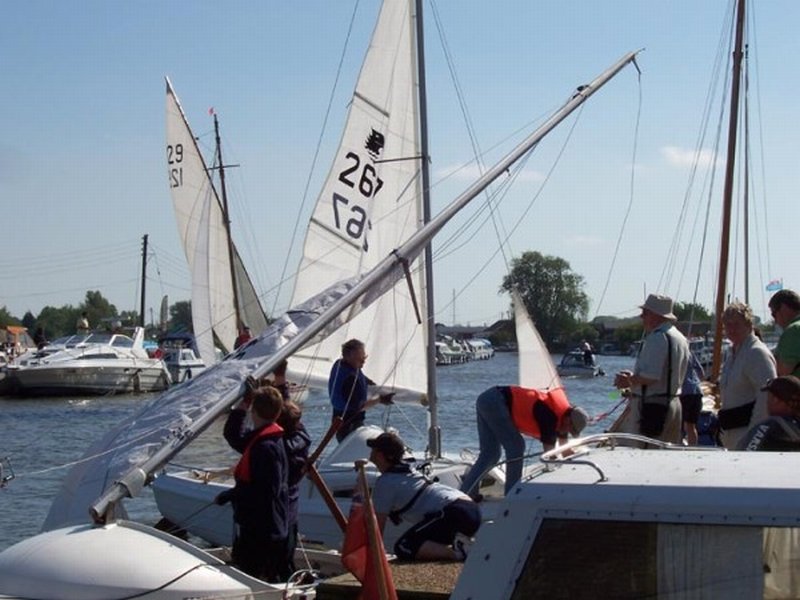
© 2006 Peter Wagstaff
With the jib dropped, Mike furls the main, while I work to release the forestay, unaware of the Yeoman mast about to descend on me.
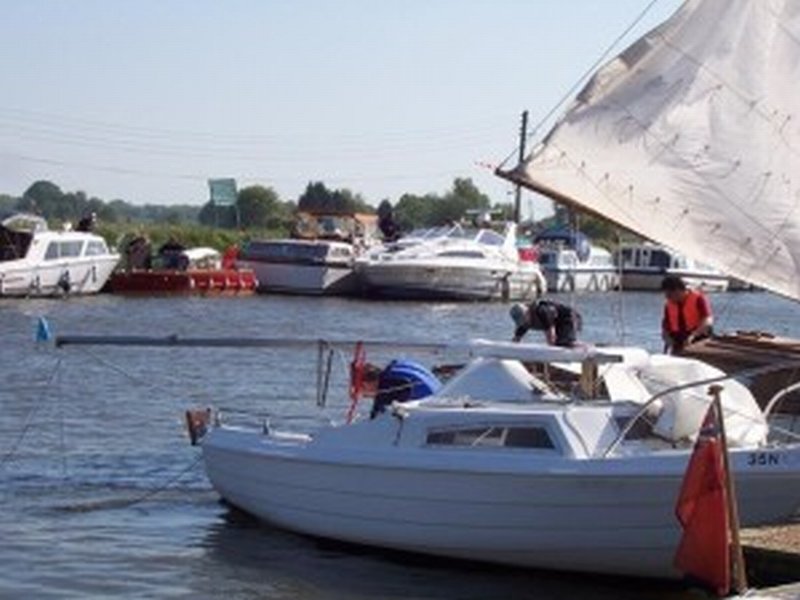
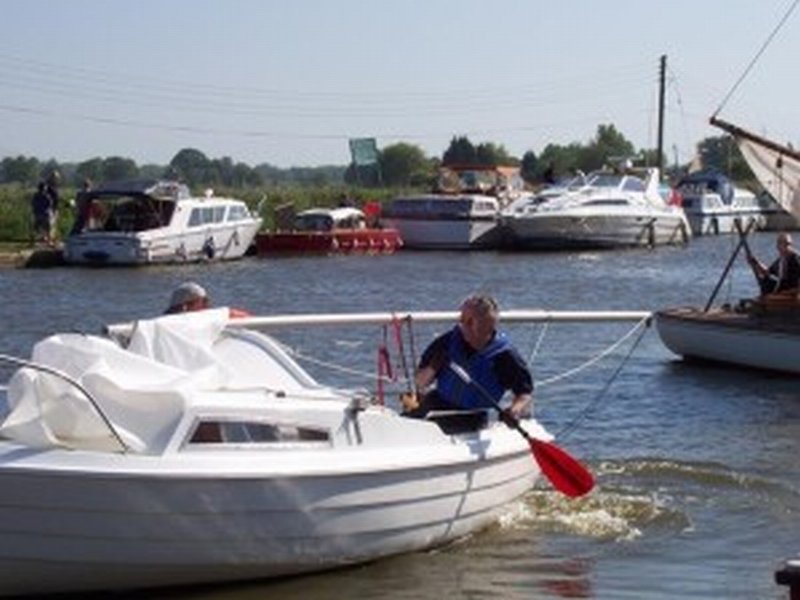
© 2006 Peter Wagstaff
Just 33 seconds separate these two pictures. The full sequence of the four pictures cover just 3 minutes 19 seconds.
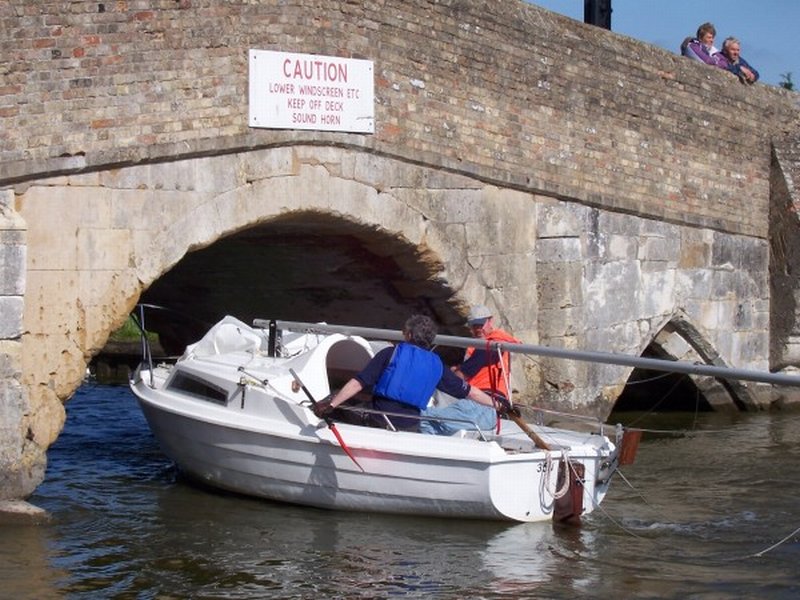
© 2006 Peter Wagstaff
There's little current and we make it through the bridge with no problems.There's a further hundred yards to paddle to clear the new by-pass bridge.
I had been aware of squeezing in the gap beside a Yeoman, but hadn't realised that this was Kevin Appleton's boat, the regular poster on the NSBroadsboating mail list. The only other boat I noticed was "Bessie Bell", River Cruiser #129, that came in just behind us. She was to make the finish in 23 hours 39 minutes, last but one boat to cross the line within the twenty four hour limit.
All went according to plan through Potter. The training session that we had done a month earlier had taught us a couple of useful lessons about dropping the mast, so we didn't disgrace ourselves, as we became the focus of interest. I was amazed to learn that, by seven o'clock the following morning, Peter Wagstaff, the owner of the letting agency for Quiet Waters, had delivered an envelope containing photographs of us dropping the mast and passing through the bridge. You can't ask for more than that from your holiday landlords, can you? He even managed to provide the the photographic evidence to back up Kevin's confession.
We had completed the passage through Potter at 16:37. Then it was on up the Thurne to Martham and the turn into Candle Dyke, past Duck Broad and Heigham Sound and on towards Hickling Broad.
 Hickling Broad
Hickling Broad
The stretch from Martham to Hickling is my home ground and it holds no problems for a SeaHawk other than some stretches where trees and scrub hold off the wind. For deep drafted craft it is a different tale.
In some places posts, which are supposed to mark the edge of the channel, can, for larger boats, appear to be half a boat's length further back than they should be. The mud is deep and it's soft and only the most perceptive of helmsmen will notice that they've hit it until the come to tack and they realise that they are caught. Except in the lightest airs getting off means first lowering the sails to avoid any chance of getting pushed further into the shallows. Then you attempt to dig yourself a channel by rocking the boat so the keel swings from side to side, clearing the silt from under you and carving out a channel. Finally, whilst all the crew and as much weight as possible is shifted aft, you send your lightest crew forward with quant pole in the hope that they will be able to find a purchase on the bank, or reeds, or worst, the mud itself, to push you off. There are other techniques, of course, especially if you are not involved in a race that commits you to not using the old "iron tops'l"!
Out on Hickling Broad itself, things can be just as bad for the big boats, especially after dark. The posts marking the channel are many yards apart and difficult to spot with ordinary torches, which, in any case, are liable to damage night vision. These days you hear of some competitors who take to using GPS receivers to determine their location and when it is time to tack. The race's organisers do their best to tempt crews out of the channel by placing the mark well up the broad, beyond the turn leading Catfield Dyke and after the distinct kink two thirds of the way across the Broad.
None of this was a problem for us. There was still plenty of light and I had never experienced a grounding anywhere on our route across to the guard boat and the mark round which we had to turn. As part of the pack of paperwork that we had received on registration had been a number of plastic tokens. It was our task to drop one of these into a bucket at each of the marks in the centre of the broads. This was our first. It went without a hitch. However, in the excitement, I forgot to make a note of when we made that mark and at almost ten past six estimated the time at 17:53.
Returning to Candle Dyke and two minutes before reaching the final narrow stretch before rejoining the Thurne, we encountered "Brown Owl", the Sailfish that I had set as my target boat to beat. That was at 18:35. A hurried conversation established that she had done both the South Walsham and Ant marks before coming up the Thurne. I was quite pleased. It placed us about an hour and twenty minutes ahead of them. I was hopeful that we could do the Fleet Dyke leg to South Walsham in something not far off that time, which meant we were neck and neck.
Everything depended on the tides. I was optimistic that we would make the Bure mark on time, getting there as the tide turned. If I had it timed right, then "Brown Owl" would be fighting the some of the Bure tide for forty minutes while we were going with it, having rounded the mark.
Having just made the turn at Martham, we were on the run down back to Potter when we spotted "Melinda" (at 18:40). This was River Cruiser #217. Richard Baguley, who had introduced me to Mollie Howes, so helped me get the necessary paperwork to take part in the race was supposed to be aboard. He was facing the other way head down in the cockpit as we passed which would account for him not claiming not to have seen me after the start when later hereported his experiences of the race on the NSBroadsboating list.
 Potter Again
Potter Again
By now, it was clear that Mike and I had got our forecast for arrival at Potter badly wrong. Perhaps that should have been a sign to us that the wind was fading. Phone calls to Quiet Waters while crossing Hickling had established that John and Angie and David and Eunice were with Liz and Mary. They all planned to come and watch us pass under Potter Bridge. Initially, we had talked of making it by around six o' clock.
In fact it was well after seven by the time we reached the complex of bridges at Potter Heigham. We didn't notice at the time, but on the far bank was Jerry Ping, another of the regulars from the NSBroadsboating list. He managed to take a series of photographs (shown earlier) showing the various stages of dropping the mast and paddling between the two bridges.
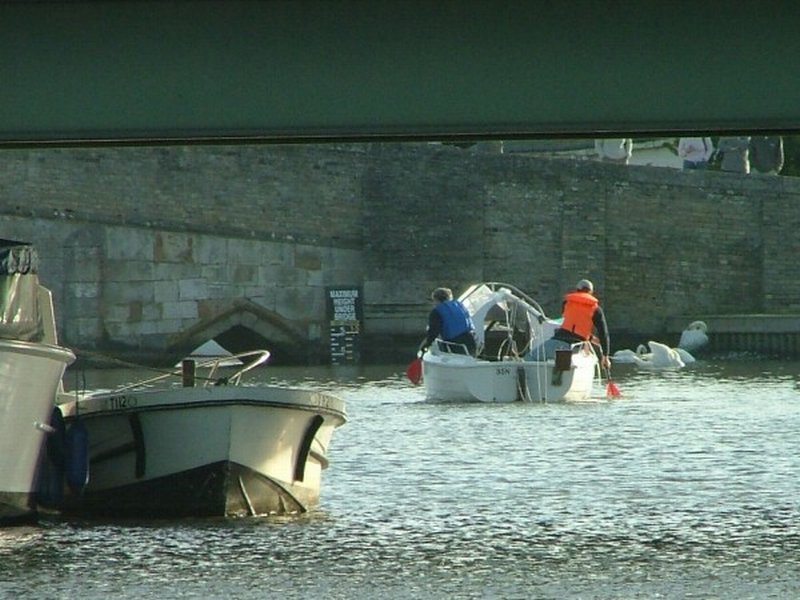
© 2006 Jerry Ping
The dash between the bridges was not too onerous as the tide was not running fast.
By that time, the breeze was beginning to become more chilly. Having been kept hanging around the bridge for an hour, Liz was quite annoyed at the delay. The more so because she reckons that I showed little interest in the family and friends gathered round the bridge when we did appear. However, one photograph, taken by David, clears shows me acknowledging the camera, giving a wave and complete with silly grin!
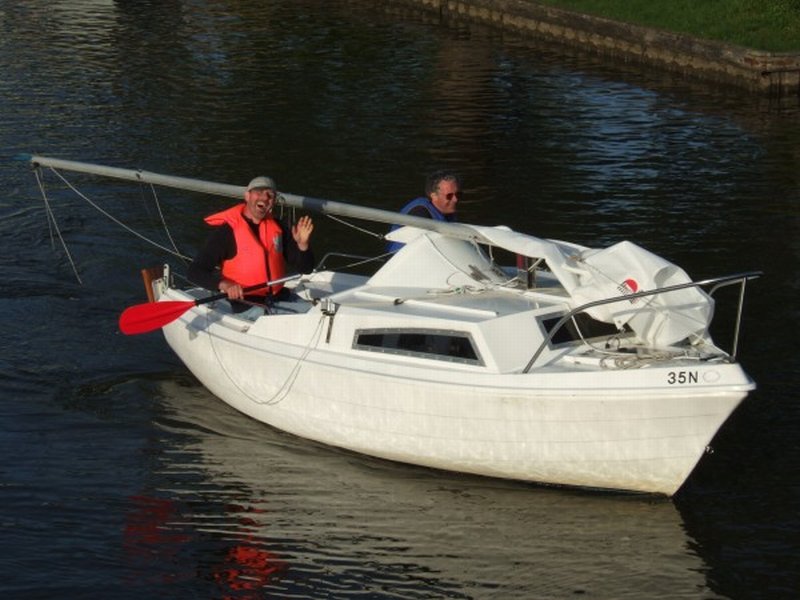
© 2006 David Gibson
Friends and relations are there to greet us as we pass under Potter Heigham bridge for the second time.
However, with the greeting done, it was back to business. As we arrived, "Zephyr" RCC #118 was leaving so we made for her space on the quay.I had no more time to spare in acknowledging family and friends. Indeed, I too was annoyed with the hoards of on-lookers.
Spectators I was prepared for. What I did not expect was whole families making the place look more like Blackpool beach at high tide on an August Bank Holiday. The hoards sat crushed around the bridge on ground sheets and deck chairs to within two feet of the waters edge, eating their fish and chips and herding their toddlers. They provided almost no room for manoeuvre when jumping ashore and seemed almost surprised that I should want to invade their space. I concentrated on the job of raising the mast and was pleased to be away without incident.
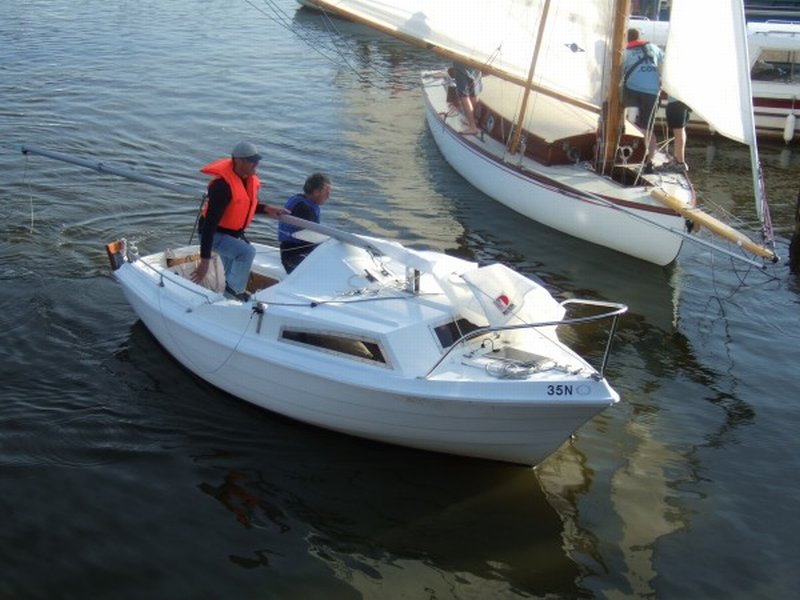
© 2006 David Gibson
Once through the bridge, we aim for the staithe to moor and raise the mast again. As we arrive "Zephyr", River Cruiser Class #118, is leaving.
 The Thurne
The Thurne
By 19:24 we had cleared both Bridges at Potter and were on our way again, passing the Helby's chalet fourteen minutes later. We had cleared the last of the holiday chalets when the wind died at around 19:50. I wasn't too worried. The tide was taking us in the right direction and there was still enough breeze to provide steerage way. There were four or five hours until I reckoned that we find slack water and by that time we should be at the mark at Stracey Arms. All was still going according to plan.There was no point in being stressed about whether we'd make the mark in time. The die was now cast and all we could do was wait it out.
Everything became more relaxed as we passed Womack Water at 20:02.For the first time since the start, I got my camera out again. It was quarter past eight as I took a photograph of the Reedling "Onyx" after she had passed us. I presume she had already done the leg down to the Stracey Arms as the results list show she finished the race at 07:40, more than nineteen hours after she started and was placed sixth, on handicap. It is interesting that "Zephyr", which had left Potter just in front of us didn't finish until 09:15. She had started twenty minutes after "Onyx" and took just over an hour and a quarter longer to complete the course. This suggests that she needed to do the South Walsham leg on the return trip as she was well ahead of Onyx at this stage.

At 20:15 we were behind Onyx, Reedling #10. Onyx finished the race at 07:40, more than nineteen hours after she started and was placed sixth, on handicap.
A few minutes later I got some excellent photographs of Thurne Mill. By this stage little more than the wake of passing craft is seen on the water.

By 20:23, when this view of Thurne Mill and the yachts moored in the dyke was taken, the clear reflections of mill and masts show the lack of wind.
 The Bure
The Bure
It was 20:50 as we reached Thurne Mouth by which time the sun was setting. Clearly, progress had dramatically slowed and I began to worry again that we would not make the mark before the tide turned. However, with what little wind there was behind us there was no more we could do to improve progress.
We hadn't really eaten much up to this point. Our plans for meals had been extremely relaxed. The girls had laden us with, it seemed, enough food for a week rather than a weekend. We had snacked on the odd sandwich, slice of cake, packet of crisps and chocolate bars. We had made tea with the hot water from our Thermos flasks. We had drunk too from cans of fizzy drinks. Even now we didn't feel in the mood for any kind of meal, and the cabin was so stuffed with gear that there was little room to place anything like a plate even if had had something more meal-like with us. So we snacked again.
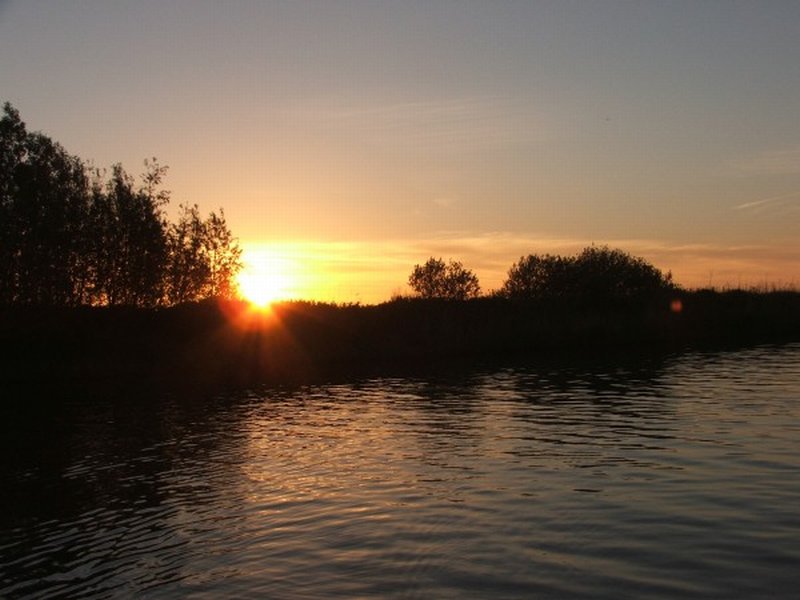
With the sun setting over the Upton Marshes and the wind virtually gone, my concern was whether we'd make the Stracey Arms before the tide turned.
With the sun gone, it got rapidly darker. Somehow we caught up with a large hire cruiser. We stayed behind them for some time. At times we were just a few feet from their stern at other times thirty yards or more away.
The half moon appeared between the clouds from time to time. Even when it was not shining clear, it was easy enough to see the banks and to tell when you were close to land. It got colder too. We could hear the chatter from the boat ahead. All that talk of tea and soup and having crew who could make it for you affected our conversation too.
"Wouldn't that be a more comfortable way to do it in future?" asked Mike. I didn't see it that way. Certainly, we needed some way of heating food and drink, to help keep us warm in the night. What I thought we needed was considerably more organisation within the cabin. The trouble with my boat was that the cabin is completely bare forward of the two quarter-berths. Anything stored forward of the twin bulkheads, at the head of the berths just rolls around in a cavernous space. Other two-berth SeaHawks have a galley unit to port and, frequently, the owners have built lockers to starboard.
Aboard "Imagination" there was just a pile of cool boxes, cheap, bulging, carrier bags, maps and tide tables, rolled up sleeping bags, and all sorts of other clutter topped with jumpers and anoraks in case of rain. More stuff was stored at the foot of the bunks under the cockpit. We had it relatively lucky. We had to bear in mind that we had had splendid weather this time. It could easily be rain, rain, and more rain another year.
I would have voted for a cooker and rather less food.Someone on one of the mail lists had posted that what mattered was not food, but a good supply of drink, hot drink if it was bad weather. I could see the sense in that. I also wanted decent storage for what was needed and nothing that we did not need. We seemed hopelessly over stocked not just with food, but almost everything else as well. Sensible places to store everything would not just be welcome, but perhaps vital in harsher conditions. We had almost no way to separate what might become wet with what needed to stay dry.
What whatever our thoughts on the boat, the one good thing was that it continued to be dry, with no sign of rain, and the tide still seemed to be ebbing as fast as ever. However, we still hadn't reached Acle Bridge and there was as far to go on the other side of the bridge as there was from Thurne Mouth. At about twenty to midnight Acle Bridge came in sight.
 Acle Bridge
Acle Bridge
I had been in two minds about how to tackle Acle. The river is wide and the span of the bridge so wide that it poses no obstruction for a small craft such as ours, other than the need to drop the mast. My only concern was whether it was worth the risk of trying to do this while under way and letting the tide carry us through.
To follow the rules of the race we wouldn't be allowed to lower the mast beyond the marks placed either side of the bridge. The trouble was that we couldn't see where they were and it is notoriously difficult to judge distances on the water after dark. The last thing I wanted was to be judged to have broken the rules by bringing the mast down early, and I worried that should anything go wrong whilst lowering the mast we had no way to stop the boat and prevent catastrophe.
In the end, the fact that the wind was on our stern, pushing us on towards the bridge, was sufficient to force my decision. We moored outside the little cabin that is Acle's Bridge Stores. One of the most handy items of equipment that Mike had come equipped with was a small LED headlamp. I strapped it on my head before I went forward to lower the mast. It proved invaluable. With both hands free, releasing the forestay was as easy as in day light. Something it most certainly would not have been with out it.
LED torches seem one of the best inventions of recent years for the Three Rivers Race. The small cheap one I had tied to the burgee halyard had been switched on as the burgee was hoisted before the start of the race. It was reckoned to have a battery life of some 80 hours, so I had figured that there was no point in having to worry about turning it on mid-way through the race at a point when we might be needing to concentrate on river traffic. And indeed it was doing exactly the job planned for it, shining straight up at the burgee with no light escaping sideways to fall foul of the regulations on masthead lights.
We passed Acle Bridge at 23:46 where we temporarily lost contact with the larger yacht, but were back in contact before Stokesby, once more hearing the constant talk of food, sleep and turns on the helm from the other boat. We finally lost them, when I took one of the bends too close to the bank and we touched the "putty". The current, more than the wind, seemed to push us on further, but the half minute it took for us to realise why we were no longer as close as we were to the other boat, then raise the keel, and stabilise the sails so they had sufficient power to take us over the shallows was sufficient for us to lose close contact with them.
 Stokesby
Stokesby
Stokesby at night was interesting. I had last seen it in daylight some thirty years ago. I know I must have done as last year I rediscovered a set of slides, taken on an Instamatic camera, dated July 1976. I recall taking them. More accurately, I remember taking a couple of them, but I have no memory at all of what the rest show. This is really weird! What traumatic event occurred that has obliterated the cruise completely from my memory. The slides show a voyage on my father's SeaHawk, from Dilham, where he had his mooring, to Oulton Broad and then up to Norwich and back to Dilham. Aboard are a couple of friends. The first photographs in the set show how we met up at my brothers house and went to an Air Show. I remember that event, though not the friends presence at it. All so very weird, especially as this would have been the only time I ventured south of Acle Bridge on Dad's boat. It should have been an extremely memorable cruise. Certainly, the weather looked splendid throughout the cruise, but... nothing!
My last memories of Stokesby go back to hire craft in the sixties. Then, I recall it as a place with few opportunities for mooring, of only ever seeing it with a fast ebbing tide, with exposed mud banks and generally looking run down and uninviting. In contrast, it's gets a warm, comforting, homely treatment by Arthur Ransome in the Swallows and Amazons books. I know I must have seen it on a rising tide too, on the return from Yarmouth, but once again my memory lets me down and I have no detailed memories to record here.
Tonight, at 01:13,the river seemed packed with moored craft, some with lights twinkling in the cabins, though most in darkness. The village itself seemed larger than I remember too. All I could recall from those previous visits was a pub that we could never visit, as the few moorings were always full. Now there were certainly some yachts with activity on board, seemingly having passed the mark at Stracey, and now waiting for the wind to be able to continue their return to Horning. Somehow, it didn't occur to me, as we slipped by all those boats, that we might find it difficult to make our way upstream too. It was now after the time that I had expected slack water and I was still anxious to press on and make the Stracey Arms mark, still a mile off, before the tide turned.
 Stracey Arms
Stracey Arms
We rounded to see a further bend ahead and the lights aboard what I guessed was the guard boat near the Stracey mark. The usual exchange took place as we gave our boat number and I noted the time as 02:22. Further round the bend I could see a cluster of boats and the buoy in the middle of the stream. Some yachts were moored a few yards above the mark, most were further downstream. I guessed that there were at least a dozen craft there, but Mike heard the guard boat say that twenty five were trapped at the mark.
There was a lot of merry banter passing between the crews of the trapped boats as we approached the mark. With hindsight, I wonder why I only realised at this point that we were not going to be able to make it back upstream. I aimed for the bank, planning to come alongside a Yeoman. We clung to them for half a minute while I collected my thoughts. They told us they'd been there since eight o' clock. It can't have been much fun for them.
It was clear that we weren't going to be able to stay with them, so I called for Mike to go ahead and get the mud weight ready. The Yeoman crew pushed us off, and as we headed for the middle of the stream Mike threw the mud weight overboard. Everyone else appeared to be moored against the bank. We alone were plumb in the middle of the river a few yards downstream of the buoy acting as the Bure mark. It wasn't what I was thinking of doing, but it did mean that if others had to tack up stream to pass us it could have made life difficult, so perhaps it wasn't such a bad move. The stream was still ebbing at some speed. So much for tide tables!
It was now obvious that we were going to be there for some time. Time for more food, so we raided the various boxes and bags once more. This was the time when you really felt you could do with something hot and I yearned for a properly fitted out galley with a stove.
I was pretty tired by this stage. With my back propped up against the cabin, I laid out along the cockpit bench and fell asleep. Mike tells me that I was snoring so loudly that he thought I was going to shake myself out of the cockpit and into the water. He woke me and ordered me below, where I promptly fell asleep again. I hadn't needed persuading to go below. When I woke it was with areal attack of feeling cold, cold to the point of hypothermia. It wasn't just my teeth that were chattering, in a way that I couldn't recall experiencing since my childhood days, my whole body was shaking. No wonder Mike had thought I might go overboard. I didn't think I was ill-clad. I had on my 3RR shirt, thick jumper, Sweatshirt, full jacket style buoyancy aid and all topped with a Barbour jacket - not to mention my waterproof trousers over my normal ones.
In the cabin it was a struggle to get comfortable. The bottom of the quarter-berths, under the cockpit benches, were stuffed full of gear and I couldn't stretch out flat. However, I did fall asleep again and somewhere out in the blackness Kevin Appleton was able to hear me "snoring very loudly", as he later reported to the NSBroadsboating list. It seems that I was asleep for quite a while. I assume that at one point Mike must have come below as well.
 Return up the Bure
Return up the Bure
The next thing I knew was that I was woken by Mike with the news that the fleet was on the move. All the boats had left all sails flying throughout the night, so there wasn't much for crews to do, except take the decision to go. Who went first, I don't know. Nor do I know whether anyone tried it too soon only to have to return to the bank. When I came to it was obvious that progress was possible.
As Mike went forward to raise the mud weight it must have been around 04:20. I had a mild panic as I struggled to pass the mark on the correct side to round it properly. I'd have hated to be penalised for merely reaching the mark and turning back without properly rounding the buoy. In my attempts to get round I didn't make the progress I should have and larger boats came past us.A woman on one said they'd named our SeaHawk the "Mary Celeste" as they could see no one on board, so I console myself that I couldn't have been snoring all the time.
As soon as the sun was up I tried to take a photograph of the fleet making its way upstream. Unfortunately it required a 1/3rd second exposure so was extremely blurry, but it gives some feeling for the massed departure from Stracey.

Forgive the blurry picture, a hand-held 1/3rd second exposure taken at 04:46, just after the fleet had departed Stracey Arms.
The tide continued to ebb till around 04:55. The breeze was very light, but reasonably steady and we made slow, but easy, progress back up to Stokesby, which we passed at 05:36. Seeing it in daylight confirmed the overnight impression that Stokesby wasn't the dour bleak place from my memory.
By now the sun was well clear of the horizon but, initially, the water still seemed unclear about whether it had the strength to raise a mist or not. It was going to be another bright day, but whether the wind would pick up as the sun rose higher was still uncertain.
I remained hopeful that we might be able to complete the race. Losing almost five hours out of the twelve that I had figured we would have to make the return up the Bure, should still be sufficient time to make it, but only if we had a reasonable breeze. However, we certainly wouldn't be eating a "Finisher's Breakfast" at Horning Sailing Club. The best we could hope for was a finisher's lunch.
All the while the fleet was spreading out and, as expected, we were amongst the slowest boats to leave the Stracey mark. However, there was one boat, a hire yacht, which we succeeded in overtaking. I must assume that it was one of the boats that we had seen the previous night at Stokesby.
The flood lasted only about three hours and the winds remained exceptionally light. Now they were variable in direction. By the time we had completed the passage under Acle Bridge at 08:09, not only was the tide against us but we were making no progress at all on some of our tacks. Of course, this was the period when the ebb would have been around its strongest. If you were to believe the forecasts, low tide was due at 12:40. That meant we'd be fighting the tide all the way back to Horning.
 The Race Aborted
The Race Aborted
It took us an hour from passing under Acle Bridge to make the long turn near Fishley Hall where the river turns northwards, a little over half a mile. Finally, at 09:18 we abandoned our attempt to complete the race. We dug the outboard out of the cabin and mounted it on the transom some three quarters of a mile south of Upton Dyke and proceeded with motor assistance up river.
Not long after that a small boat came down river, with race stewards aboard. They told us that we would have been declared retired had we got as far as the guard boat at Thurne Mouth, so that confirmed our race as officially over.
At 09:38 we passed Upton Dyke and reached Thurne Mouth at 10:45. Because, I only have an electric outboard, with an expected duration, on my battery, of only a few hours, we took the decision to head straight for Hickling. Our time up the Bure took longer than it might have as we ran the motor at half power, to ensure maximum battery life. Experience on Hickling had taught me that this seems to produce almost as fast a speed as maximum power, but with much less energy consumed, so I was hopeful we might make it all the way back to Hickling under motor, if it proved necessary. I was, also hopeful that the winds would return and repeat the pattern of the previous few days. Sure enough, shortly after eleven o'clock we were able to turn the engine off and return to sail power. We completed passage of Potter Heigham bridges at around quarter to one.
Moored just above the by-pass bridge at Potter we saw a stunning looking, and particularly narrow beamed, River Cruiser. It's crew apparently taking lunch in the cockpit. We moved off first, but it overtook us later. There is much talk these days about the need for more dredging on the Broads. As if I didn't already have sympathy with that view, the need for dredging was confirmed when we saw this craft, in mid channel, stuck fast on the bottom at the junction of Meadow Dyke, which leads off to Horsey Mere.
Across Hickling I made my usual short cut across the Broad and was astounded when for the first time ever there was a sound of scrapping shingle. There was no doubt about it, we'd hit bottom. Of course, it was just a matter of grabbing the handle in the cabin threshold and lifting and we were free, but it did make me wonder if the lack of depth had any relation to the interminable ebb tide the previous night.
Journey's end was the Pleasure Boat Inn. My mooring is right outside the pub. However, for the first time, I was to find my space half occupied by a hire cruiser. I don't recall it this way, but Liz reports that I was more than a little grumpy. Certainly, I was frustrated. "Imagination" had been away a fortnight and with a mooring outside the pub, I was always aware that there was a risk that someone might occupy my space. We tried what we could to locate the people who had left it there, asking those in the pub garden and trying to find the landlord of the pub to see if he knew anything of the boat. Liz had other ideas about what I should be doing. Maybe she was right. In the end we took the boat across to the opposite side of the dyke and waited.Eventually, one of the other boats further down the dyke left. We loosened the mooring lines and shifted the cruiser further along to give us the space to get "Imagination" into her berth.
 Do It Again?
Do It Again?
Once back at Quiet Waters, we could finally relax and find out about the visitors that had dropped in on Liz and Mary and about the pet they had adopted, a heron that seemed to always be about patrolling the plot on which Quiet Waters stood.
Liz was still annoyed at me for being so grumpy at the end of it all.
Looking back, we hadn't had a bad race. Right up till the last few hours I felt we were in with a chance of making the finish on time. It must be extremely hard if you realise that you have made the wrong decision much earlier on in the race. It would be worse still had there been a lot of rain. All in all, we had had a very gentle introduction to the Three Rivers Race. For spectators, it had been near perfect weather.
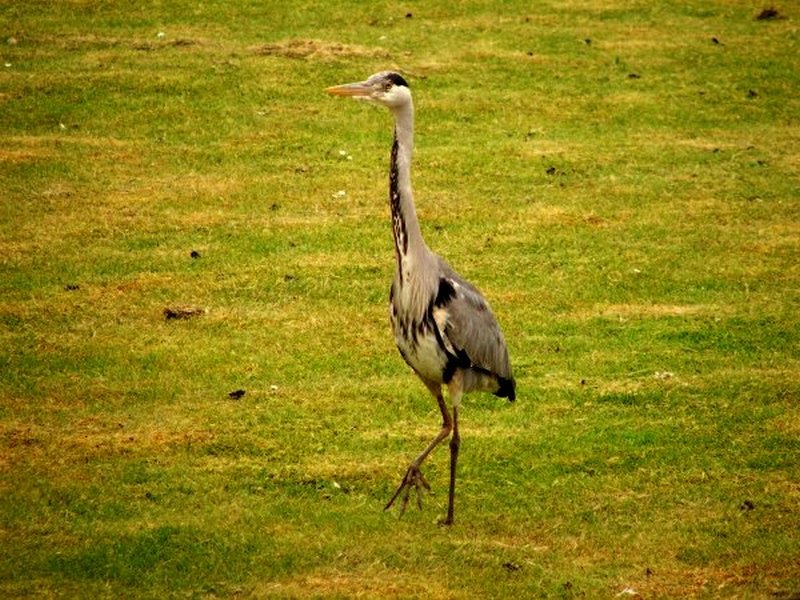
Once we were back at Quiet Waters we were introduced to the pet heron that patrolled the plot in spite of the presence of Zena.
Everyone tells me that the conventional answer to the question, "Will you try again?", posed immediately after finishing the Three Rivers, should be reminiscent of that given by Steve Redgrave "If you ever catch me in this race again, shoot me!" What I can report is that my brother's response was "Ask me later", but when he phoned a couple of days later it had changed to, "Why don't you sell the SeaHawk, then we could hire a yacht with room for extra crew to provide food and drink and bunks to sleep on." Liz, whose love of water stops when it involves quantities larger than a bath full, anticipating his drift, cried, "Never, never, never!"
